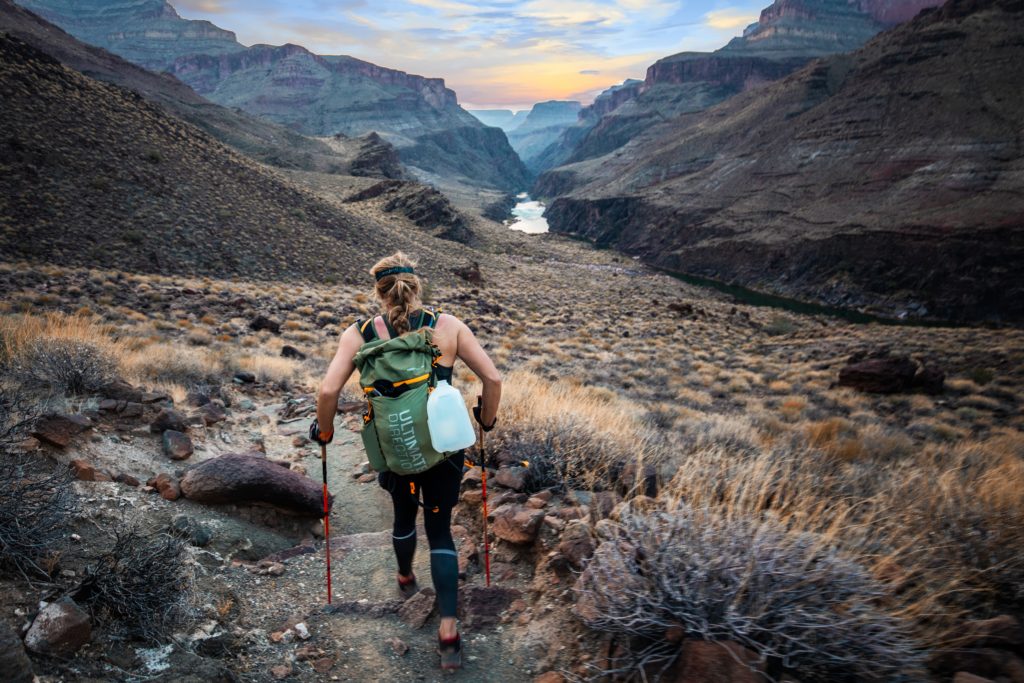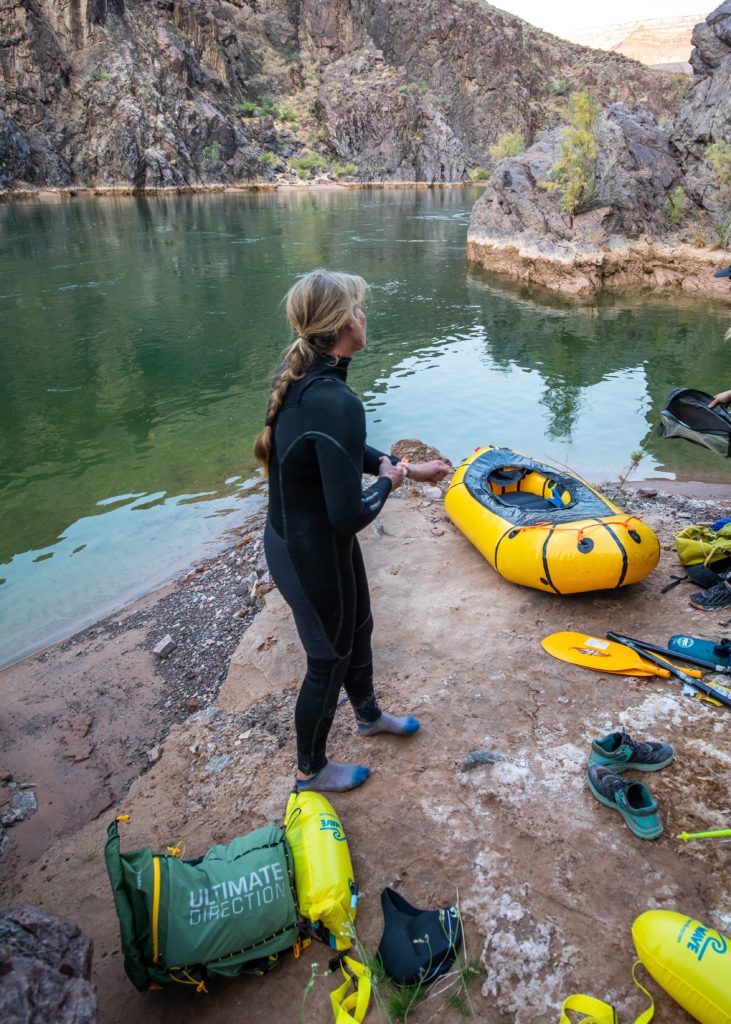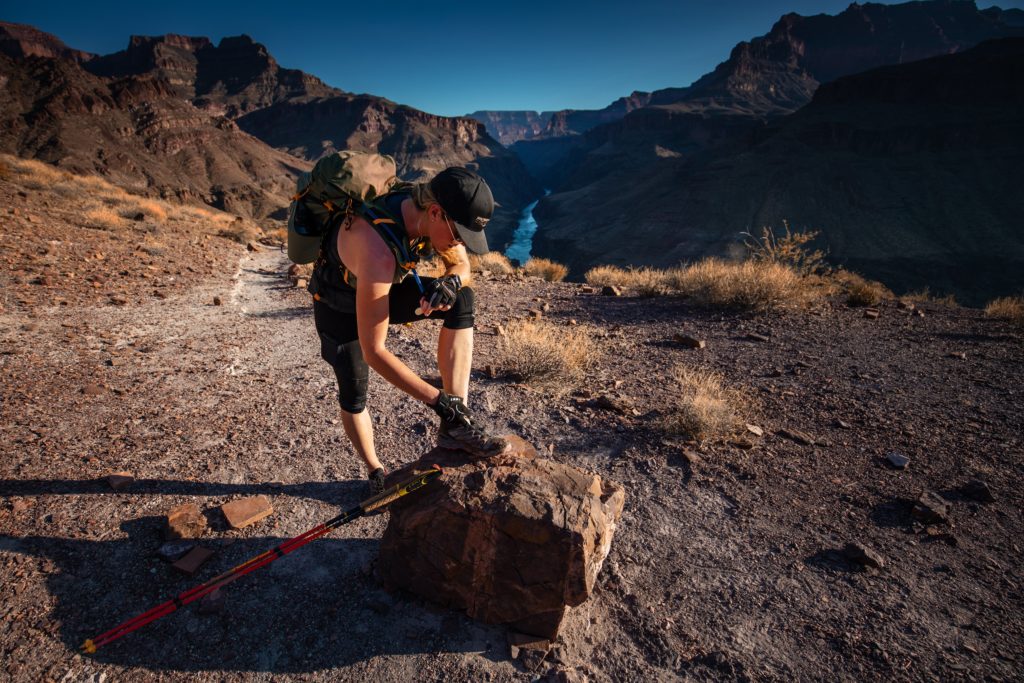By Ultimate Direction athlete, Suzanne (Sunny) Stroeer
On October 23rd, 2020, Suzanne Stroeer, Christin Healy and Lexi Miller set the Women’s unsupported FKT on the Grand Canyon R2R2R-Alt in 22h 27m 20s. This is Suzanne’s story.

I like goals that keep me on the edge of my chair: goals where I’m not sure if I’ll be able to achieve what I’ve set out to accomplish. That’s one of the many reasons why, last fall, I set out to tackle setting the women’s FKT on the Grand Canyon R2R2R-alt with my friends Christin Healey and Lexi Miller.
Everybody knows the Grand Canyon Rim-to-Rim-to-Rim (R2R2R) route — but that’s not what we had our sights on. Yes, I’ve run the R2R2R multiple times, and I love it, but it’s a known quantity. The trails are fast and crowded. There is infrastructure. There are maps and trip reports and Strava logs galore.
What I was after, together with Christin and Lexi, is the “alt” version of the R2R2R: a route so remote that even getting to the trailhead is an adventure. A route that no woman had ever completed until we came along, and a route most pointedly different from the standard R2R2R in that it lacks all infrastructure – no rest houses, no water spigots, no Phantom Ranch, and no bridge across the Colorado river.
The R2R2R-alt requires crossing the Colorado twice: by swimming or paddling across. The river of course is freezing cold, and not to be taken lightly – even though Rob Krar and Mike Foote’s recent skinny-dipping FKT on the route just about set the gold standard for a light-hearted approach to getting across.

When Christin, Lexi and I strategized the route, we took the opposite approach: we wanted to make sure that we would be safe in our crossing, and – between the three of us – hauled two full-length wetsuits and a pack raft from the rim to the river and back. With water, nutrition, wetsuit, and emergency gear, I was glad for my Ultimate Direction Fastpack 40. Where Christin and Lexi opted to carry regular backpacking packs at the beginning of our speed mission (and light running vests for the far side of the river), I was able to use my Fastpack on both the near and the far side of the river. The Fastpack delivered exactly what I needed on this FKT mission: comfort, volume, and adjustability.
The strategy that Christin, Lexi and I decided on was diametrically opposed to how Rob Krar and Mike Foote approached their December 2020 FKT on the route – and that’s OK. All of us succeeded on our own terms. That’s the beauty of pursuing FKTs: you can make them as long or as short, as fast, or as slow, as mellow, or as consequential as you would like. For Rob and Mike, the prize was competitive performance and bettering the Coconino Cowboy’s prior record on the route.

For Christin, Lexi, and myself, it was all about adventure and inviting other women into this remote arena. Time and speed were secondary. The next women’s team pursuing a record on this route won’t have that same luxury – but they’ll have the knowledge that skinny-dipping across the Colorado is an option.
Interested in shopping Ultimate Direction’s new 2021 Fastpack and FastpackHer line up for your next FKT? Click here.
Thinking about your own FKT? Here are the four essentials that FKT-setter-extraordinaire, Suzanne Stroeer, considers prior to any speed attempt.
- Strategy. Be absolutely explicit: just how far and how fast are you planning to go? Are you supported or unsupported? How difficult and remote is what you’re attempting? Are you planning to complete your route at all costs, or is there a time/weather cut off at which you would bail?
- Gear. What equipment do you need to support your strategy? Less gear of course means less weight means faster progress, but also less safety. I have set speed records carrying nothing other than a gel and 300ml of water in my HydroTights; on the other extreme, for my speed record on the Aconcagua 360 I had a 70l backpack complete with stove, crampons, and a -20F sleeping bag on the upper mountain. For the Grand Canyon R2R2R-Alt FKT, I used Ultimate Direction’s new 2021 Fastpack 40.
- Contingencies. Know the what-ifs. What happens if you bust an ankle and are unable to keep yourself safe through motion? If you’re in the front country or with a support crew, it may not be an issue. If you are unsupported deep in the backcountry, you have to have a contingency plan that’s separate from relying on the kindness of strangers or the SOS button of your GPS device.
- Mindset. Having the first three elements – strategy, gear, and contingencies – all figured out is what allows you to put your head down and get it done. Because in the end, your success on a record attempt doesn’t just depend on your training and your preparation; if those are squared away, the biggest question that remains is how bad you want it. And if you want it bad enough, you may just find yourself jumping into the Colorado River in your birthday suit – or running with a wetsuit and pack raft on your back.
Comments (0)